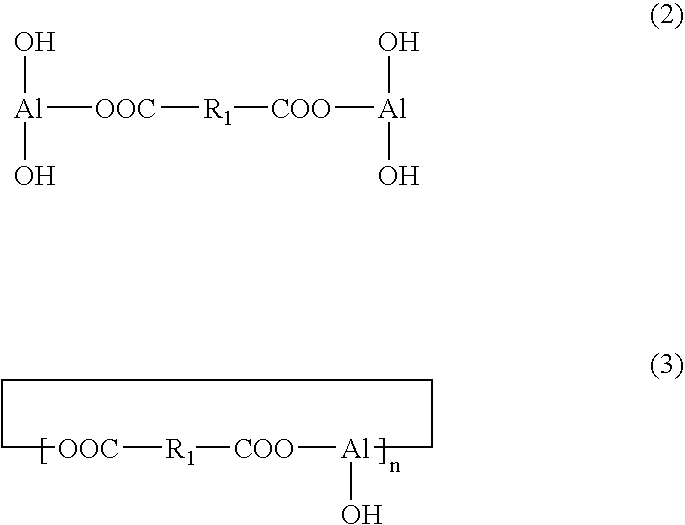Latex composition comprising a cross-linking agent and molded product thereof
- Summary
- Abstract
- Description
- Claims
- Application Information
AI Technical Summary
Benefits of technology
Problems solved by technology
Method used
Image
Examples
examples 1 to 4
[0238]0.5 part of ammonia (3% aqueous solution of ammonia) and 0.25, 0.5, 0.75, or 1.0 part of a compound having one structure represented by the general formula (I), dihydroxyaluminum octylate, were added to 100 parts by weight (in terms of a solid content) of an NK-223. On the next day, 1.2 parts of active zinc white (Bayer: zinc oxide) were added to the mixture.
[0239]After that, deionized water was added to the mixture to adjust the latex concentration of the mixture to 33%, whereby a dip-forming composition was obtained.
examples 5 to 22
[0240]In each of Examples 5 to 22, a dip-forming composition was obtained by adding any one of various organometallic crosslinking agents to a raw material latex as shown in Table 1.
[0241]Table 1 shows the test results of the respective molded bodies.
[0242]Evaluation
[0243]In Comparative Example 1, the crosslinking of carboxyl groups is achieved with zinc oxide alone, and the crosslinking is a typical cluster ion crosslinking system. As can be seen from the results, the measured physical properties of the surface of the composition of Comparative Example 1, such as a tensile strength and an elongation did not largely differ from the results of the examples, but the durability test for rubber of which the composition was composed was terminated 2 days after the initiation of the test because the rubber elongated during a wearing test owing to its low creep resistance. A particularly outstanding feature lies in the fact that a rubber film made of the composition whitens owing to sweat ...
examples 23 to 27
[0258]0.3 part of the C12 aluminum alkenyl succinic acid soap (Example 23), 0.3 part of dihydroxyaluminum rosinate (Example 24), 1.0 part of the C12 aluminium alkenyl succinic acid soap (Example 25), 1.0 part of dihydroxyaluminum rosinate (Example 26), or 0.3 part of dihydroxytitanium lactate (Example 27) was added to 100 parts by weight of an NK-223. On the next day, colloidal magnesium hydroxide (0.4 part (in terms of MgO) in each of Examples 23, 24, and 27 or 0.2 part (in terms of MgO) in each of Examples 25 and 26) was added to the mixture, whereby a dip-forming composition was obtained. The latex concentration of the composition was adjusted to 30%.
[0259]Table 2 shows the test results of the dip-formed articles of Examples 23 to 27.
[0260]Evaluation
[0261]Each of Examples 23 and 24 shows that the addition of a small amount of an organic aluminum metal crosslinking agent to colloidal magnesium hydroxide improves the creep resistance and water resistance of a colloidal magnesium hy...
PUM
| Property | Measurement | Unit |
|---|---|---|
| Fraction | aaaaa | aaaaa |
| Fraction | aaaaa | aaaaa |
| Fraction | aaaaa | aaaaa |
Abstract
Description
Claims
Application Information
 Login to View More
Login to View More - R&D
- Intellectual Property
- Life Sciences
- Materials
- Tech Scout
- Unparalleled Data Quality
- Higher Quality Content
- 60% Fewer Hallucinations
Browse by: Latest US Patents, China's latest patents, Technical Efficacy Thesaurus, Application Domain, Technology Topic, Popular Technical Reports.
© 2025 PatSnap. All rights reserved.Legal|Privacy policy|Modern Slavery Act Transparency Statement|Sitemap|About US| Contact US: help@patsnap.com



